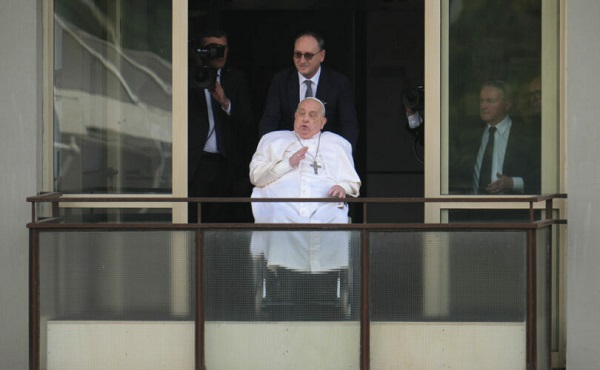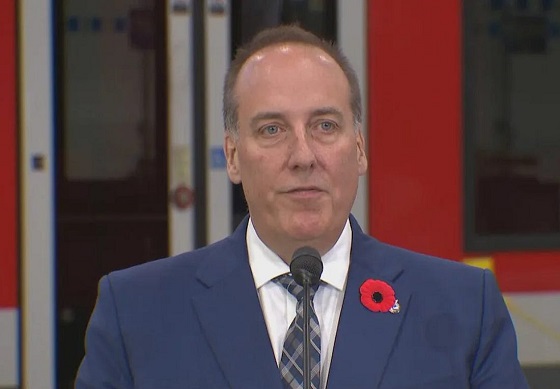International
Pope Francis appears frail as he returns to Vatican following 38-day hospital stay

From LifeSiteNews
By Michael Haynes, Snr. Vatican Correspondent
The Pope blessed the gathered crowd at Rome’s Gemelli hospital before leaving to return to his Vatican residence.
Pope Francis made his return to the Vatican Sunday, after first greeting crowds from the balcony of the Gemelli hospital.
For the first time in 38 days, Pope Francis appeared before the public eye on Sunday. Greeting crowds who had gathered outside the Gemelli hospital where he has been treated for double pneumonia since February 14, Francis was noticeably weakened and frail.
He wore no nasal cannulas during his less than three minute greeting on the balcony. But the toll of being without oxygen was marked, as Francis appeared particularly breathless as he was wheeled back inside.
Pope Francis gives a blessing from the Gemelli hospital window at Angelus time this morning, marking first time he has been seen since February 14.
He has now returned to the Vatican after leaving the hospital earlier today. https://t.co/jOFgg1envg pic.twitter.com/2TQhgRpLNV
— Michael Haynes 🇻🇦 (@MLJHaynes) March 23, 2025
Francis thanked the crowds before singling out and praising a woman who had brought a bouquet of flowers with her.
Accompanied by his personal nurse Massimiliano Strappetti, Francis did not seem able to raise his arms freely. After a very brief few words of thanks, Francis had to be reminded to give his blessing before then being wheeled inside by Strappetti.
This was the first time the Pope had been seen in-person since his hospitalization in mid-February – an event which his doctors noted Saturday was fraught with considerable life-threatening danger for the Pope.
Following his balcony appearance – which was live-streamed on the Vatican News media channels – Francis was driven back to the Vatican in his customary Fiat 500. But he made an unscheduled stop at St. Mary Major’s on the journey, giving the bouquet of flowers he had noticed at the hospital to the Cardinal Rolandas Makrickas, the co-adjutor priest of Francis’ favored Roman basilica.
The event was in keeping with Francis’ long-established custom of visiting the icon of Mary, Salus Populi Romani, in the basilica before and after every papal trip he has made. Indeed he has announced his desire to be buried in the basilica, and preparations have begun accordingly to ready an area close to the icon for his interment.
As stipulated by his doctors on Saturday, Francis will now begin a convalescence period of at least two months.
His motor and respiratory therapy will continue, as evidenced by the undeniable need for oxygen yesterday when he did not use it for three minutes on the balcony.
Doctors stated during Saturday’s press conference that Francis nearly lost his life twice during his time in the hospital, confirming reports which had circulated about the Pope’s condition. Indeed, Dr. Sergio Alfieri, who leads the Pope’s medical team, said that when Francis was hospitalized February 14 he “presented [with] an acute respiratory failure,” which led to “severe” double pneumonia.
Doctor leading Pope Francis' medical team confirms past seriousness of Francis' condition, incl 2 times his life was in danger
When Francis was hospitalized Feb 14 he "presented [with] an acute respiratory failure," which led to "severe" double pneumonia.
Details on @LifeSite https://t.co/2aSyyMA99g pic.twitter.com/sfBJaYhLzo— Michael Haynes 🇻🇦 (@MLJHaynes) March 22, 2025
Nurse Strappetti and Dr. Luigi Carbone – who is deputy director of the Health and Hygiene Department of Vatican City State and Francis’ physician in the Vatican – will coordinate the daily medical care of the Pope.
His social contact is limited by necessity as doctors warn about the danger of his contracting any new infection. As such, it will likely be the case that his already small inner circle of three secretaries and medical staff will be those who form part of Francis’ daily household.
While a regular visitor in the Pope’s normal schedule, Cardinal Secretary of State Pietro Parolin only visited Francis three times in his 38-day hospitalization. Such a distance between them would suggest that Parolin himself might not be anticipated to be as regular a visitor as in the past.
For now, though, Francis’ pontificate is going to be placed under particular scrutiny. He has returned to the Vatican but he is expected to be a much more hidden and vocally quiet pontiff than before.
Yet perhaps, bereft of voice, he will focus more on issuing documents and pushing through agendas he has long had in mind – such as the recent three-year extension of the Synod on Synodality.
Doctors described him as eager to return to work. His appearance on Sunday gave the impression of a man much more frail than the image painted by his clinical team.
Whether a quiet period will descend upon Vatican hill, or a season of frenzied activity begins, now remains to be seen.
Regardless, speculation of a conclave has already long begun thanks to Francis’ hospitalization, and cardinals will likely be ever more on the lookout for candidates as the year progresses.
Artificial Intelligence
AI Faces Energy Problem With Only One Solution, Oil and Gas


From the Daily Caller News Foundation
Which came first, the chicken or the egg? It’s one of the grand conundrums of history, and it is one that is impacting the rapidly expanding AI datacenter industry related to feeding its voracious electricity needs.
Which comes first, the datacenters or the electricity required to make them go? Without the power, nothing works. It must exist first, or the datacenter won’t go. Without the datacenter, the AI tech doesn’t go, either.
Logic would dictate that datacenter developers who plan to source their power needs with proprietary generation would build it first, before the datacenter is completed. But logic is never simple when billions in capital investment is at risk, along with the need to generate profits as quickly as possible.
Dear Readers:
As a nonprofit, we are dependent on the generosity of our readers.
Please consider making a small donation of any amount here.
Thank you!
Building a power plant is a multi-year project, which itself involves heavy capital investment, and few developers have years to wait. The competition with China to win the race to become the global standard setters in the AI realm is happening now, not in 2027, when a new natural gas plant might be ready to go, or in 2035, the soonest you can reasonably hope to have a new nuclear plant in operation.
Some developers still virtue signal about wind and solar, but the industry’s 99.999% uptime requirement renders them impractical for this role. Besides, with the IRA subsidies on their way out, the economics no longer work.
So, if the datacenter is the chicken in this analogy and the electricity is the egg, real-world considerations dictate that, in most cases, the chicken must come first. That currently leaves many datacenter developers little choice but to force their big demand loads onto the local grid, often straining available capacity and causing utility rates to rise for all customers in the process.
This reality created a ready-made political issue that was exploited by Democrats in the recent Virginia and New Jersey elections, as they laid all the blame on their party’s favorite bogeyman, President Donald Trump. Never mind that this dynamic began long before Jan. 20, when Joe Biden’s autopen was still in charge: This isn’t about the pesky details, but about politics.
In New Jersey, Democrat winner Mikie Sherrill exploited the demonization tactic, telling voters she plans to declare a state of emergency on utility costs and freeze consumers’ utility rates upon being sworn into office. What happens after that wasn’t specified, but it made a good siren song to voters struggling to pay their utility bills each month while still making ends meet.
In her Virginia campaign, Democrat gubernatorial winner Abigail Spanberger attracted votes with a promise to force datacenter developers to “pay their own way and their fair share” of the rising costs of electricity in her state. How she would make that happen is anyone’s guess and really didn’t matter: It was the tactic that counted, and big tech makes for almost as good a bogeyman as Trump or oil companies.
For the Big Tech developers, this is one of the reputational prices they must pay for putting the chicken before the egg. On the positive side, though, this reality is creating big opportunity in other states like Texas. There, big oil companies Chevron and ExxonMobil are both in talks with hyperscalers to help meet their electricity needs.
Chevron has plans to build a massive power generation facility that would exploit its own Permian Basin natural gas production to provide as much as 2.5 gigawatts of power to regional datacenters. CEO Mike Wirth says his team expects to make a final investment decision early next year with a target to have the first plant up and running by the end of 2027.
ExxonMobil CEO Darren Woods recently detailed his company’s plans to leverage its expertise in the realm of carbon capture and storage to help developers lower their emissions profiles when sourcing their needs via natural gas generation.
“We secured locations. We’ve got the existing infrastructure, certainly have the know-how in terms of the technology of capturing, transporting and storing [carbon dioxide],” Woods told investors.
It’s an opportunity-rich environment in which companies must strive to find ways to put the eggs before the chickens before ambitious politicians insert themselves into the process. As the recent elections showed, the time remaining to get that done is growing short.
David Blackmon is an energy writer and consultant based in Texas. He spent 40 years in the oil and gas business, where he specialized in public policy and communications.
Dr John Campbell
Cures for Cancer? A new study shows incredible results from cheap generic drug Fenbendazole

From Dr. John Campbell
You won’t hear much about Fenbendazole from the regular pipeline of medical information. There could be many reasons for that. For one, it’s primarily known for it’s use in veterinary medicine. Somehow during COVID the medical information pipeline convinced millions that if a drug is used on horses or other animals it couldn’t work for humans. Not sure how they got away with that one considering the use of animal trials for much of modern medical history.
Another possible reason, one that makes at least as much sense, is that there’s no business case for Fenbendazole. It’s been around for decades and its patent expired in the early 1990’s. That means it’s considered a generic drug that a pharmaceutical company from India could (and does) produce in mass quantities for very little profit (compared to non-generics).
So Fenbendazole is an inexpensive, widely accessible antiparasitic drug used in veterinary medicine. During the COVID pandemic a number of doctors, desperate for a suitable treatment, tried it with reportedly great levels of success. Over some time they discovered it might be useful elsewhere. Some doctors are using Fenbendazole to help treat late stage cancer. Often this is prescribed when the regular treatments clearly aren’t working and cancer is approaching or has already been declared stage 4.
What they’ve found at least in some cases is astounding results. This has resulted in a new study which medical researcher Dr. John Campbell shares in this video.
-

 Energy2 days ago
Energy2 days agoIt should not take a crisis for Canada to develop the resources that make people and communities thrive.
-

 Artificial Intelligence1 day ago
Artificial Intelligence1 day agoAI Faces Energy Problem With Only One Solution, Oil and Gas
-

 Health1 day ago
Health1 day agoLack of adequate health care pushing Canadians toward assisted suicide
-

 National24 hours ago
National24 hours agoWatchdog Demands Answers as MP Chris d’Entremont Crosses Floor
-

 Media23 hours ago
Media23 hours agoBreaking News: the public actually expects journalists to determine the truth of statements they report
-

 Business18 hours ago
Business18 hours agoLiberal’s green spending putting Canada on a road to ruin
-

 Artificial Intelligence23 hours ago
Artificial Intelligence23 hours agoAI seems fairly impressed by Pierre Poilievre’s ability to communicate
-

 Alberta24 hours ago
Alberta24 hours agoATA Collect $72 Million in Dues But Couldn’t Pay Striking Teachers a Dime



